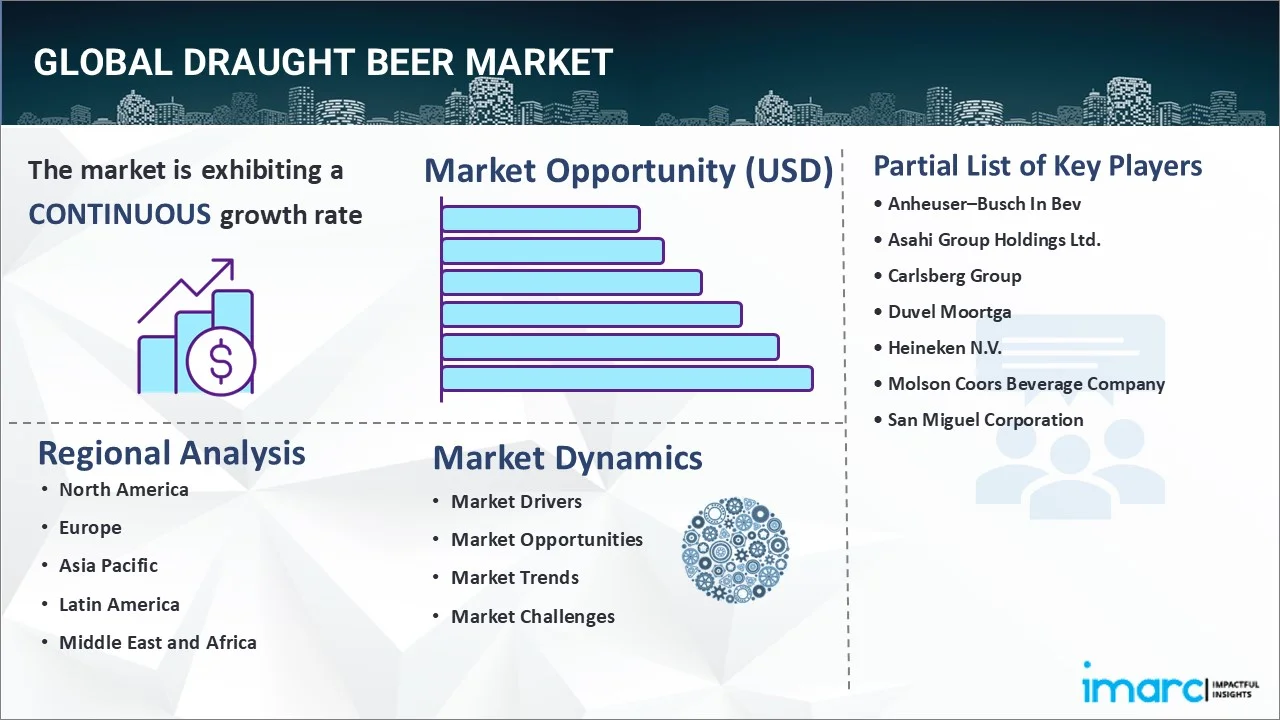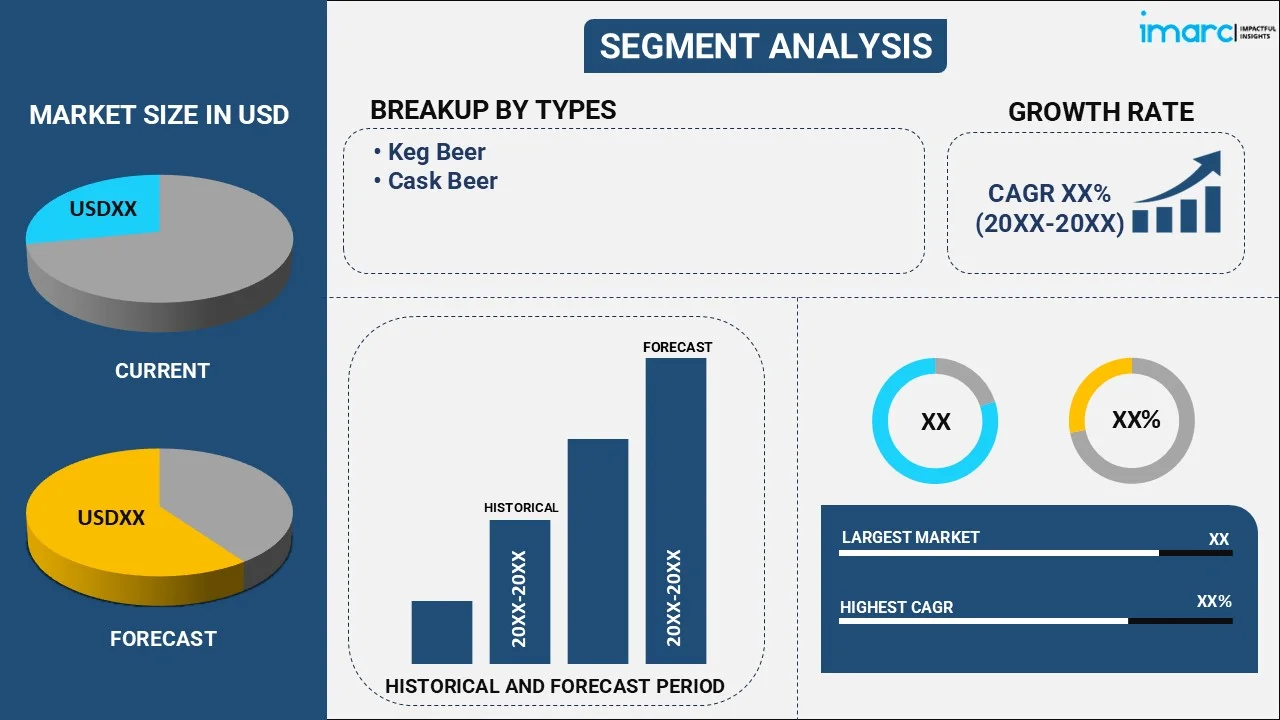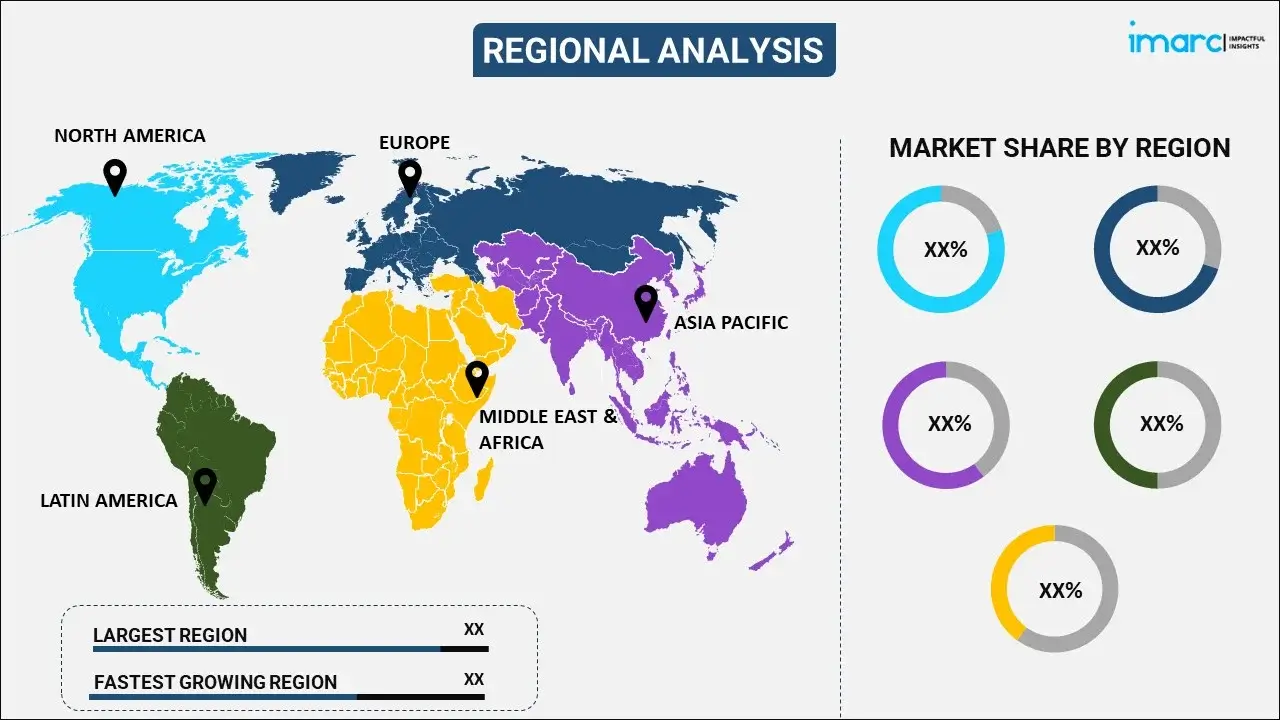
Draught Beer Market Report by Type (Keg Beer, Cask Beer), Production Type (Macro Breweries, Microbreweries), Category Type (Super Premium, Premium, Regular), End Use (Commercial Use, Home Use), and Region 2025-2033
Market Overview:
The global draught beer market size reached USD 16.6 Billion in 2024. Looking forward, IMARC Group expects the market to reach USD 20.3 Billion by 2033, exhibiting a growth rate (CAGR) of 2.2% during 2025-2033. The growing consumption of alcohol among the masses, rising popularity of beer tourism among beer enthusiasts, and increasing trend of serving alcohol at various parties, occasions, or celebrations are some of the major factors propelling the market.
|
Report Attribute
|
Key Statistics
|
|---|---|
|
Base Year
|
2024 |
|
Forecast Years
|
2025-2033
|
|
Historical Years
|
2019-2024
|
| Market Size in 2024 | USD 16.6 Billion |
| Market Forecast in 2033 | USD 20.3 Billion |
| Market Growth Rate (2025-2033) | 2.2% |
Draught beer refers to beer that is dispensed from a keg or cask using a tap system. It is often carbonated using carbon dioxide (CO2) or a mixture of CO2 and nitrogen (N2) to achieve the desired level of carbonation and foam. It is typically served at a colder temperature and possesses a characteristic creamy texture due to the carbonation process. It is enjoyed in social settings, such as bars, pubs, and restaurants, where it is served on tap. It is often preferred by beer enthusiasts and connoisseurs who appreciate the freshness, flavor, and mouthfeel that is offered by draught beer.

At present, the increasing demand for draught beer as the carbonation process in draught beer produces a smooth texture with a well-formed head of foam, providing a visually appealing presentation, is impelling the growth of the market. Besides this, the rising popularity of draught beer, as it allows beer enthusiasts to explore a wide variety of flavors, styles, and seasonal brews, is contributing to the market growth. In addition, the growing utilization of kegs for packaging draught beer, as it is a more sustainable option and retains the original flavor of the beverage, is offering a favorable market outlook. Apart from this, the increasing trend of serving alcohol at various parties, occasions, or celebrations is supporting the growth of the market. Additionally, the increasing number of nightclubs, pubs, and restaurants serving alcohol to customers is bolstering the growth of the market.
Draught Beer Market Trends/Drivers:
Rising consumption of alcohol
There is a rise in the consumption of alcohol among the masses is influenced by social and cultural influences, economic factors, and changes in the lifestyle of individuals. In many societies, alcohol is deeply ingrained in social gatherings, celebrations, and recreational activities. It is often seen as a way to relax, socialize, and bond with others. Peer pressure and social expectations also play a role, as individuals may feel compelled to drink in order to fit in or conform to societal norms. Moreover, marketing and advertising strategies employed by alcohol companies are contributing to increasing consumption by promoting their products as desirable and attractive. Furthermore, the stress and pressures of modern life may contribute to increased alcohol consumption as individuals seek temporary relief or escape from their daily challenges. The consumption of alcoholic beverages, such as draught beer, is often seen to unwind or cope with stress and anxiety.
Increasing popularity of beer tourism
Beer tourism is gaining traction globally, with individuals seeking immersive experiences at breweries, brewpubs, and taprooms. Visitors enjoy brewery tours, beer tastings, and the opportunity to try fresh draught beer directly from the source. This trend is positively influencing the consumption and sales of draught beer, particularly in regions known for their beer culture. When beer enthusiasts travel to different breweries and regions known for their brewing expertise, they are exposed to diverse brewing traditions, ingredients, and styles. This exposure fuels inspiration and encourages brewers to experiment with new recipes and techniques, leading to the development of unique and exciting draught beers. Furthermore, beer tourism plays a crucial role in promoting local and regional breweries, thereby boosting their visibility and sales.
Growing demand for efficient dispensing systems
The demand for efficient beer dispensing systems is experiencing a significant increase due to changing consumer preferences, the rising consumption of alcoholic beverages, and the need for cost-effective and sustainable solutions. Modern beer enthusiasts are becoming more discerning and knowledgeable about beer quality and flavor. They seek out venues that can deliver a consistent and high-quality beer-drinking experience. Efficient dispensing systems play a crucial role in maintaining the integrity of the beer, ensuring that it is served at the right temperature, with the correct level of carbonation, and without any contaminants. Moreover, by providing a reliable and consistent beer-drinking experience, these systems enhance customer satisfaction and increase the demand for draught beer.
Draught Beer Industry Segmentation:
IMARC Group provides an analysis of the key trends in each segment of the global draught beer market report, along with forecasts at the global, regional and country levels for 2025-2033. Our report has categorized the market based on type, production type, category type, and end-use.
Breakup by Type:

- Keg Beer
- Cask Beer
Keg beer dominates the market
The report has provided a detailed breakup and analysis of the market based on the type. This includes keg beer and cask beer. According to the report, keg beer represented the largest segment.
Keg beer is a traditional and popular method of storing and serving beer that has been around for centuries. It is a beer that is served directly from a keg rather than from a bottle or can. The process of serving beer from a keg involves a specialized system that uses CO2 or a mix of it and N2 to push the beer out of the keg and through the tap. This preserves the carbonation and flavor of the beer, ensuring that it tastes just as the brewer intended.
Cask beer, also known as real ale or cask-conditioned beer, is a traditional method of brewing and serving beer. It is served without any external gas pressure, using a process known as gravity dispensing, where the beer is simply allowed to flow out of the tap by its own weight. Alternatively, it is served using a beer engine, which is a hand pump used to draw the beer from the cask without adding any extra carbon dioxide.
Breakup by Production Type:
- Macro Breweries
- Microbreweries
Macro breweries holds the largest share of the market
A detailed breakup and analysis of the market based on the production type has also been provided in the report. This includes macro breweries and microbreweries. According to the report, macro breweries accounted for the largest market share.
A macro brewery is a large-scale brewing facility specifically designed for extensive beer production. It is capable of producing millions of barrels of beer per year, consistently ensuring a broad distribution reach. It is equipped with industrial-grade equipment and technology, facilitating efficient and high-capacity brewing, fermentation, and packaging operations. It focuses on few beer styles, often lagers or light ales, which are designed to appeal to a broad consumer base. It has the resources to maintain strict quality control protocols, ensuring that each bottle or can of beer tastes the same, regardless of when or where it is produced.
Microbreweries are small-scale breweries that produce beer in limited quantities. These operations prioritize quality and flavor over mass production, often embracing innovative brewing techniques and unique ingredients. They stand out for their emphasis on quality, flavor, and brewing technique. Unlike large-scale breweries, which often focus on consistency and mass-market appeal, microbreweries are more likely to experiment with a wide array of ingredients and brewing styles. Furthermore, many microbreweries are committed to sustainability. They strive to minimize their environmental footprint through measures, such as energy efficiency, water conservation, and waste reduction.
Breakup by Category Type:
- Super Premium
- Premium
- Regular
Regular holds the largest share of the market
A detailed breakup and analysis of the market based on the category type has also been provided in the report. This includes super premium, premium, and regular. According to the report, regular accounted for the largest market share.
Regular draught beer is a beer that is served from a cask or keg rather than a bottle or can. It is affordable and is available in bars, pubs, and restaurants with a tap system installed.
Super premium draught beers refer to beers that are considered to be of exceptionally high quality, often brewed using top-tier ingredients and advanced brewing techniques. These beers are more expensive than their mainstream counterparts and are marketed toward consumers seeking a superior beer-drinking experience.
Premium beer is used to denote a segment of the draught beer market that typically falls between mainstream, mass-market beers and the higher-end super premium in terms of price, quality, and, often, flavor complexity. It is brewed with a higher quality of ingredients compared to mainstream beers. This can include the use of more expensive types of malted grain, different or higher quality varieties of hops, or specially selected strains of yeast.
Breakup by End Use:
- Commercial Use
- Home Use
A detailed breakup and analysis of the market based on the end use has also been provided in the report. This includes commercial use and home use.
Draught beer, also known as draft beer or tap beer, refers to beer that is served directly from a keg or cask instead of being bottled. It is a popular choice in bars, restaurants, and pubs due to its unique characteristics and fresh taste. The commercial use of draught beer plays a significant role in the beer industry, contributing to its popularity and profitability. For breweries, the commercial use of draught beer serves as an efficient marketing tool. Many breweries collaborate with bars and restaurants to serve their beers on tap, effectively promoting their brand to a broader audience.
Draught beer is also enjoyed at homes by utilizing home draught systems for efficient dispensing. With the right equipment and setup, it is possible for beer enthusiasts to enjoy the fresh and authentic taste of draught beer right in the comfort of their homes. Home use of draught beer is gaining popularity as more people seek to recreate the pub-like experience and explore a wider variety of beer styles at home.
Breakup by Region:

- North America
- United States
- Canada
- Europe
- Germany
- France
- United Kingdom
- Italy
- Spain
- Others
- Asia Pacific
- China
- Japan
- India
- South Korea
- Australia
- Indonesia
- Others
- Latin America
- Brazil
- Mexico
- Others
- Middle East and Africa
Europe exhibits a clear dominance, accounting for the largest draught beer market share
The report has also provided a comprehensive analysis of all the major regional markets, which include North America (the United States and Canada); Europe (Germany, France, the United Kingdom, Italy, Spain, and others); Asia Pacific (China, Japan, India, South Korea, Australia, Indonesia, and others); Latin America (Brazil, Mexico, and others); and the Middle East and Africa.
Europe held the biggest market share due to the rising consumption of alcohol among the masses. Besides this, the increasing number of breweries specializing in manufacturing premium quality draught beer is propelling the growth of the market.
Apart from this, the increasing popularity of beer tourism in the region is contributing to the growth of the market. Moreover, the rising number of sustainable breweries focusing on lowering their carbon footprint is strengthening the growth of the market.
North America is estimated to expand further in this domain due to the rising availability of draught beer in restaurants, pubs, and nightclubs. Besides this, the increasing adoption of improved keg designs and more efficient cooling and dispensing technology is bolstering the growth of the market.
Competitive Landscape:
Key market players are developing a draught system known as PureDraught that uses a recyclable, one-way PET keg, reducing the cost and environmental impact of traditional stainless-steel kegs. They are also focusing on manufacturing small, portable draught systems designed for use in venues with limited space or for home use. Top companies are adopting efficient keg leasing and management programs to enhance distribution without the upfront cost and logistical complexities of owning their own keg fleets. They are also developing a line of compact, automated brewing appliances that make it easy for anyone to brew their own beer at home. Leading companies are focusing on creating systems that fill beer cups from the bottom, increasing pouring speed, reducing spillage, and providing an interesting conversation starter for patrons.
The report has provided a comprehensive analysis of the competitive landscape in the market. Detailed profiles of all major companies have also been provided. Some of the key players in the market include:
- Anheuser–Busch In Bev
- Asahi Group Holdings Ltd.
- Carlsberg Group
- Duvel Moortga
- Heineken N.V.
- Molson Coors Beverage Company
- San Miguel Corporation
Draught Beer Market Report Scope:
| Report Features | Details |
|---|---|
| Base Year of the Analysis | 2024 |
| Historical Period | 2019-2024 |
| Forecast Period | 2025-2033 |
| Units | Billion USD |
| Scope of the Report | Exploration of Historical and Forecast Trends, Industry Catalysts and Challenges, Segment-Wise Historical and Predictive Market Assessment:
|
| Types Covered | Keg Beer, Cask Beer |
| Production Types Covered | Macro Breweries, Microbreweries |
| Category Types Covered | Super Premium, Premium, Regular |
| End Uses Covered | Commercial Use, Home Use |
| Regions Covered | Asia Pacific, Europe, North America, Latin America, Middle East and Africa |
| Countries Covered | United States, Canada, Germany, France, United Kingdom, Italy, Spain, China, Japan, India, South Korea, Australia, Indonesia, Brazil, Mexico |
| Companies Covered | Anheuser–Busch In Bev, Asahi Group Holdings Ltd., Carlsberg Group, Duvel Moortga, Heineken N.V., Molson Coors Beverage Company, San Miguel Corporation, etc. |
| Customization Scope | 10% Free Customization |
| Post-Sale Analyst Support | 10-12 Weeks |
| Delivery Format | PDF and Excel through Email (We can also provide the editable version of the report in PPT/Word format on special request) |
Key Questions Answered in This Report:
- How has the global draught beer market performed so far, and how will it perform in the coming years?
- What are the drivers, restraints, and opportunities in the global draught beer market?
- What is the impact of each driver, restraint, and opportunity on the global draught beer market?
- What are the key regional markets?
- Which countries represent the most attractive draught beer market?
- What is the breakup of the market based on the type?
- Which is the most attractive type in the draught beer market?
- What is the breakup of the market based on the production type?
- Which is the most attractive production type in the draught beer market?
- What is the breakup of the market based on the category type?
- Which is the most attractive category type in the draught beer market?
- What is the breakup of the market based on the end use?
- Which is the most attractive end use in the draught beer market?
- What is the competitive structure of the global draught beer market?
- Who are the key players/companies in the global draught beer market?
Key Benefits for Stakeholders:
- IMARC’s report offers a comprehensive quantitative analysis of various market segments, historical and current market trends, market forecasts, and dynamics of the draught beer market from 2019-2033.
- The research study provides the latest information on the market drivers, challenges, and opportunities in the global draught beer market.
- The study maps the leading, as well as the fastest-growing, regional markets. It further enables stakeholders to identify the key country-level markets within each region.
- Porter's five forces analysis assists stakeholders in assessing the impact of new entrants, competitive rivalry, supplier power, buyer power, and the threat of substitution. It helps stakeholders to analyze the level of competition within the draught beer industry and its attractiveness.
- Competitive landscape allows stakeholders to understand their competitive environment and provides an insight into the current positions of key players in the market.
Need more help?
- Speak to our experienced analysts for insights on the current market scenarios.
- Include additional segments and countries to customize the report as per your requirement.
- Gain an unparalleled competitive advantage in your domain by understanding how to utilize the report and positively impacting your operations and revenue.
- For further assistance, please connect with our analysts.
 Request Customization
Request Customization
 Speak to an Analyst
Speak to an Analyst
 Request Brochure
Request Brochure
 Inquire Before Buying
Inquire Before Buying




.webp)




.webp)












